The ovarian cyst is a sac or bubble formed on the epithelial layer of the organ and filled with serous contents. Small cysts have practically no clinical manifestations and are detected by chance. If the formation is large, a woman can feel strong drawing pains, which are usually combined with other symptoms. Inflammation of the cyst in a woman raises the temperature, there are signs of general intoxication of the body.
The most unpleasant complication that can occur with an ovarian cyst is its rupture. If the cyst was inflamed, a pus may enter the peritoneal cavity. Almost in 80% of cases it ends with acute peritonitis and can cause sepsis development, therefore any cysts should be controlled by a doctor and, if necessary, removed. In order not to start pathology, a woman should know the signs and symptoms of cystic ovary formations.
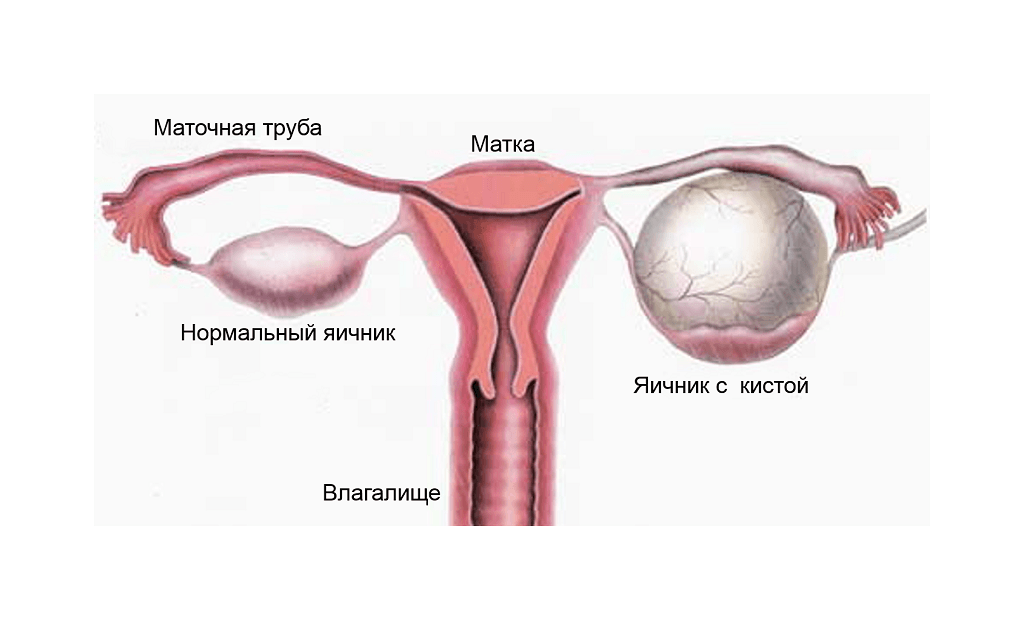
Symptoms of ovarian cyst in women
Content of material
- 1 Variety of formations and their features
- 2 How not to miss the disease: the first symptoms of
- 3 Nonspecific symptoms
- 4 Dangerous symptoms
- 4.1 Video - Ovarian cysts
- 5 Cyst disruption: signs and symptoms
- 5.1 Video - What isovarian cyst? Do I need to delete it?
Variety of formations and their features
In almost half of cases, women are diagnosed with follicular cysts that result from pathological growth of the dominant follicle. Normally, during the ovulation period, the follicle should be ruptured to release a mature egg. At the site of the rupture, a yellow body forms, which produces the progesterone necessary for pregnancy. If this does not happen, the follicle continues to grow and fill with fluid, swelling of the ovary tissue appears. The size of follicular cysts can reach up to 15-20 cm.
Sometimes other types of cysts are identified in women, the classification of which is presented in the table below.
| Type of education | Characteristic |
|---|---|
| Cystic formation of the yellow body | Appears if the pregnancy does not occur after ovulation( not always).Such formations usually resolve themselves, but in some cases they can lead to bleeding. In this situation, the woman will be treated |
| Functional | It is formed under the influence of hormones during and after ovulation. Usually does not require treatment and resolves after 1-1,5 months |
| Paraovarial | The formation that occurs in the appendages( in the part immediately above the ovaries).At small sizes, such cysts do not bother the woman for a long time, but in the case of accelerated growth or the onset of the inflammatory process, severe acute pains caused by pressure on the ovaries and adjacent organs can occur. |
| Hemorrhagic | Formed as a result of damage to the blood vessels inside the follicle or yellow body and accompanied bysevere pain from the localization of education |
| Organic | Serious pathology requiring surgical treatment. The cause of the formation of organic cysts are endocrine diseases, in which the synthesis of sex hormones is disrupted, as well as the pathology in the ovaries |
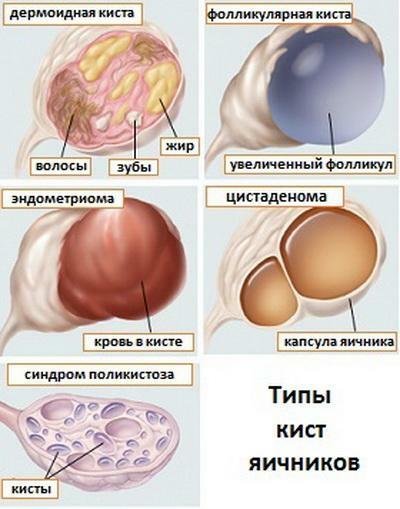
Types of ovarian cysts
Important! In the absence of treatment, cysts can degenerate into malignant tumors and cause ovarian cancer. Also, the risk of infertility and violations in the functioning of the organs of the reproductive system is high. Not all cystic formations require treatment, but medical control is necessary for any type of cyst, so it is important to pay attention to pathological symptoms and signs and to consult a doctor in time.
How not to miss the disease: the first symptoms of
Diagnosis of cystic ovarian formations is a difficult task, since at the initial stages the pathology does not have any symptoms. The signs of the ovarian cyst may be mild, so most women do not pay attention to possible abnormalities.
The most common( and often the only) symptom of cystic tumor growth is pain during menstruation and ovulation. This clinical sign is rarely perceived by someone as a pathological condition, since the pulling pains in the lower abdomen during this period are normal and are caused by the physiological features of the processes occurring in the female body.
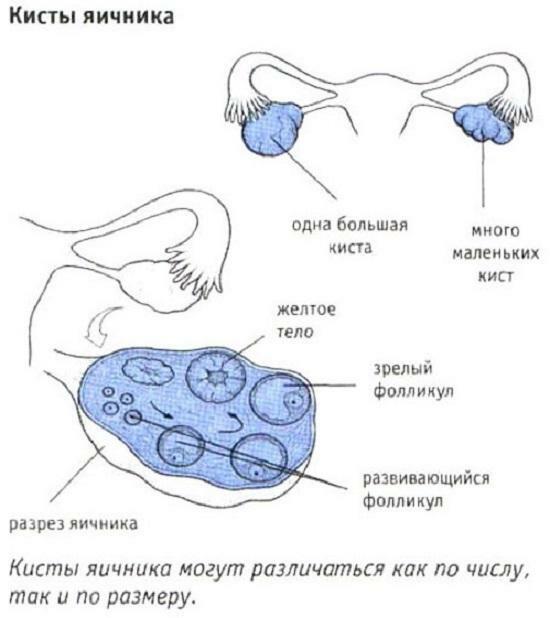
Ovarian cyst
Please note! To suspect the presence of ovarian cysts, it is possible if pain during menstruation has a pronounced intensity and does not go away for several days after the discharge is complete. It is necessary to consult a doctor if the pain remains strong 2-3 days after ovulation - physiological pain in this period should end.
Problems with the menstrual cycle - another reason to undergo the examination. They can be caused by a huge number of diseases, but exclude the possibility of cystic formations can only be after ultrasound diagnosis. Symptoms of pathology include the following symptoms:
- cycle irregularity;
- menorrhagia( long-term menstruation, accompanied by a large number of blood secretions);
- brown and bloody discharge in the intervals between menstruation;
- pressure in the pelvic floor.
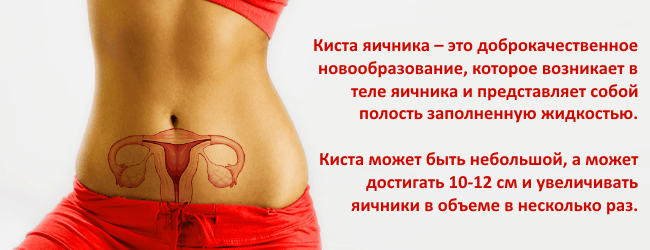
What is the
Ovarian Cyst Important! One of the symptoms that allow the doctor to assume about the presence of cystic ovarian tumors is the pain in the vagina. They can intensify after sexual contact or increased physical exertion and be accompanied by spotting.
All symptoms in this pathology should be evaluated in a comprehensive manner, because individually they do not give an accurate clinical picture. Before going to a doctor, a woman is recommended to write down all complaints about the leaflet - this will help to make the correct diagnosis faster.
Nonspecific Symptoms of
Ovarian cysts can cause symptoms that are not characteristic of reproductive tract pathologies. One of such signs is nausea and dizziness, which arise or intensify after intimacy, sports, climbing stairs and other kinds of loads, in which the lower half of the trunk is involved. Of course, talk about cystic formations in the presence of only this sign can not, but it can substantially supplement the clinical picture of the pathology and help the doctor to assign the correct methods of diagnosis and treatment.
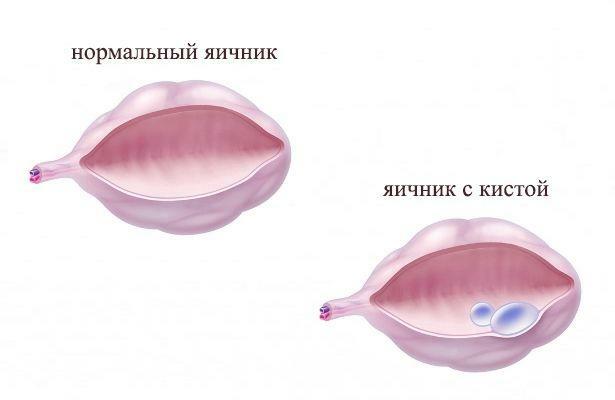
Difference between healthy ovary and ovarian
Another nonspecific symptom is the feeling of pressure during defecation or urination. Painful sensations in ovarian cysts do not occur, but there may be severe compression in the lateral part of the abdomen from the side of the affected ovary.
Important! To distinguish the ovarian cyst from inflammatory diseases of the urinary system( cystitis, pyelonephritis) can be by the nature of the sensations. With cystitis, pain during bladder emptying is cutting, stitching, high intensity and often accompanied by burning. In cystic tumors such a picture is not observed.
Dangerous symptoms of
As the cystic tumor grows, the intensity of pain and other symptoms increases. If the cyst begins to grow, it can be regarded as an alarming symptom requiring medical intervention. If a cyst rupture occurs, the consequences can be very severe, so it is important to know the dangerous symptoms and consult a doctor immediately when they occur.
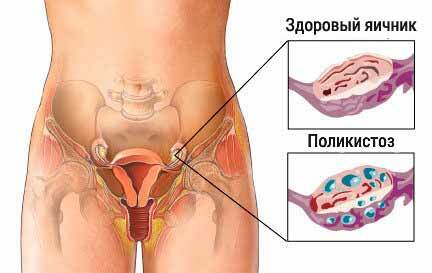
Polycystic ovary
These manifestations include:
- weakness and dizziness;
- abundant spotting in the middle of the menstrual cycle;
- decrease in body weight while maintaining the old way of life and nutrition;
- increased blood pressure;
- transition of the pain syndrome to the abdominal region;
- increase in the amount of liquid consumed;
- hair growth on face and body.
If the cyst has become inflamed, the cavity of formation begins to fill with pus. In this case, the woman will have fever, fever, minor convulsive syndrome, chills. The pain becomes very strong, does not allow to carry out usual affairs. There are painful sensations in the lateral part and lower abdomen, sometimes they can spread to the waist region and the coccygeal zone.
With a very large size of the cystic tumor, the doctor will be able to determine the formation during palpation of the abdomen. In this case, a woman must necessarily be consulted oncologist, ultrasound of the pelvic organs and the abdominal cavity, an analysis for oncomarkers and laparoscopy of the ovaries.
Important! The presence of seals can be a sign of malignant damage to the ovary. Outwardly, the woman has an increase in the circumference of the abdomen. To exclude the possibility of cancer, a distant cyst must be sent for histological examination.
Video - Ovarian cyst
Ruptured cysts: signs and symptoms
A ruptured cyst is a dangerous complication that can be avoided by regularly undergoing examination at a gynecologist. Peritonitis, which can develop as a result of the ingress of serous fluid and pus into the cavity of the peritoneum, is dangerous for a woman's life, so you can not ignore the alarming signs. A favorable prognosis( including in terms of preservation of the ovaries) with a cyst rupture is possible only if timely assistance is provided. To go to the hospital or call an ambulance is necessary when the following symptoms appear:
- brown and spotting with mucous contents;
- acute and cutting pain in the lower abdomen, gradually turning into the upper parts;
- is an unconscious condition( there may be a loss of consciousness);
- blushing of the mucous membranes of the oral cavity and skin;
- vomiting;
- attack of hypotension( lowering of blood pressure).
The temperature at the rupture of the cyst is in the range of 38-40 ° C and is not confused with traditional antipyretic drugs. It is advisable not to take any medications before the arrival of the medical team, as this may affect the clinical picture of the pathology and make it more difficult to diagnose.
Video - What is an ovarian cyst? Do I need to delete it?
Ovarian cyst in most cases appears as a result of physiological causes and passes independently without the use of drug correction and surgical treatment. Despite this, any cystic formations should be under the control of a specialist, since the risk of inflammation and complications is high. You can not exclude the likelihood of cancer, so for any symptoms of the pathological process and worsening of well-being, you need to contact your doctor.



